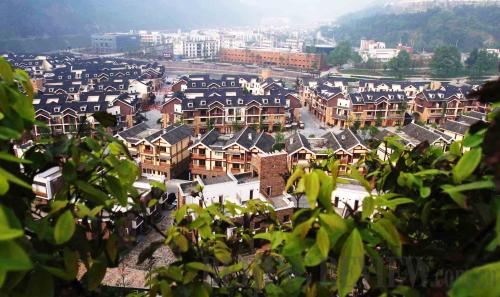|
 |
|
BETTER LIFE: The beautifully rebuilt Yingxiu Town, Wenchuan County (DUAN YAN) |
 |
|
(CHEN GANG) |
For a traveler from Beijing, accustomed to the semiarid expanses of the northern plains, arriving in Sichuan Province looks somewhat like entering a mirage. A Land of Cockaigne, bathed in countless streams running from the Himalayas to the Chengdu Plain, land of mixture of Han and minorities, and door to the Tibetan world, Sichuan is also one of the most important conservatories for fauna and flora in China. Rolling across the plain toward Beichuan Qiang Autonomous County, one embraces a myriad of fields, from which emerge the curved shapes of farmers engaged in transplanting the young rice, while wading birds fish in an irrigation canal.
But this appearance disguises a less rosy reality, because Sichuan is also located in an area with high seismic activity. Not far from the zone of confrontation between the Indian and Eurasian plates, as if nature had so wanted to remind people there is a price to be paid for so many gifts. Since ancient time the province has been a victim of devastating earthquakes.
The 2008 earthquake shook an area three times the size of Belgium. Within minutes, tens of thousands of people were buried under the rubble, more than 400,000 buildings had collapsed, leaving 4.8 million people homeless. Immediately, 130,000 People's Liberation Army soldiers were deployed to do the rescue mission, and you could see the national and international solidarity come into play. Because of the hilly region and the extent of damage, some places were rendered particularly difficult to access, especially as aftershocks continued for several days, causing mudslides and landslides responsible for new victims.
Like rescue operations, the plan for reconstruction of the region, decided once the situation stabilized, was applied with an amazing speed and demonstrated the ability of the Chinese Government to organize projects on a vast scale.
Beichuan County paid the heaviest toll in the earthquake. Given its position wedged between the steep mountains, Beichuan was subject to the direct destruction from the earthquake and landslides. Taking into account this particular geographic location, the government decided to move the entire district a few miles away from its old location, a wasteland crossing the Anchang River.
Beichuan has received massive aid from Shandong Province. The Central Government, for the sake of efficient use of national unity, assigned an investor to each rebuilding project.
When we visited the new Beichuan County, most of the reconstruction work was completed. The government rebuilt a city according to the model of the destroyed one.
The new county is divided into different areas: the residential areas for families from Beichuan, the commercial buildings, and the cultural district including a library, an art museum, a cultural center, a stadium, a gymnasium, hospitals and tourist attraction.
Han Guijun, an official of the county, said that the principle behind the reconstruction work was that "the most beautiful buildings are houses, the most advanced are hospitals, and the safest are the schools. "
One of the most important general consequences to the post-earthquake Sichuan is that this event has forced every city, town or district to reconsider its entire business model, specially where earthquake hazards are now known to be too voluminous to install new plants.
One fact deserves to be emphasized as it underscores how the new economic model for the region is part of the macroeconomic development of west China. In Beichuan, car manufacturers from Liaoning Province have decided to set up two factories in the county. For these companies, the relocation can find local labor cheaper than coastal areas, and begin to exploit the commercial potential. For residents, it is obviously a blessing in terms of job opportunities, but also the opportunity to see migrant workers coming home.
For many other places we visited, tourism came naturally as the solution to consider sustainable economic transition.
Before the quake, the small town of Shuimo was a major industrial center in the region. After the earthquake, the town decided to rebuild its factories in Chengdu, capital city of Sichuan. This allowed the town to exploit its tourism potential.
Planning efforts undertaken by the Central Government during the complex process of reconstruction should not be ignored. The reconstruction of the quake-hit areas in Sichuan is a new initiative that offers better prospects for the future development.
Wu Yuhua, an official of Deyang City, explained that every town has benefitted from the expertise of a city planner, which is the first in the country's history. This form planning proved advantageous in many respects. It helps to modernize the countryside in a much more rational and efficient way. The concentration of housing greatly facilitates the work of wastewater treatment and gas installation.
The author is a French living in Beijing and working for Chinafrica | 